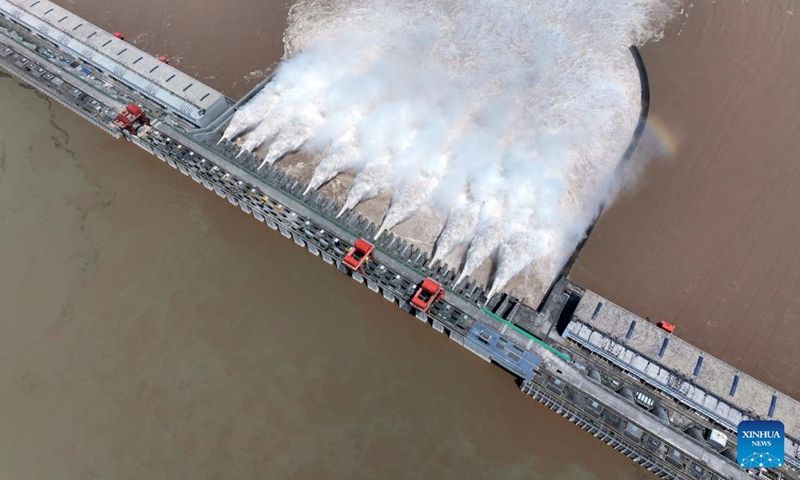Emergency response for flooding maintained in 10 provinces as China enters critical flood crest season

Water gushes out from the Three Gorges Dam through nine of its flood discharge gates to spare more capacity for incoming floods from upper reaches of the Yangtze River, in central China's Hubei Province, July 15, 2024. Photo: Xinhua
As China has entered the critical flood crest season, the Ministry of Water Resources is currently maintaining a level-III emergency response for flooding in two provinces – East China’s Anhui Province and Central China’s Hunan Province – and a lower level-IV emergency response for flooding in eight provinces – East China’s Jiangsu, Jiangxi and Shandong, Central China’s Hubei and Henan, Northwest China’s Shaanxi and Gansu – state-owned broadcaster CCTV reported Wednesday.
July 16 to August 15 is China’s critical flood prevention period. The China Meteorological Administration continued to issue orange rainstorm warnings and blue alerts for severe convective weather on Tuesday.
The Ministry of Water Resources announced on Wednesday morning that a total of 81 rivers were above warning levels due to the impact of heavy rain. Among them, the Jialing River in Gansu, the Hongru River in Henan, and the Xihe River, a tributary of Chaohu Lake in Anhui, were maintaining levels above the danger mark.
On Tuesday, the State Flood Control and Drought Relief Headquarters, along with the Ministry of Emergency Management, organized a special joint meeting with relevant departments to analyze and study the development of rainfall and flood situations in the 10 provinces, according to media outlets on Wednesday.
The meeting pointed out that heavy rainfall has continued in areas such as Shandong, Jiangsu, Anhui, with extreme weather conditions and high disaster risks in some areas; Shaanxi and Gansu have fragile geological conditions, with prominent risks of flash floods and geological disasters; in the Sichuan Basin, heavy rainfall is overlapping with previous high levels, leading to a high likelihood of secondary disasters; water levels in the upper and middle reaches of the Yangtze River and the main stream of the Huaihe River may rise again, putting pressure on embankment inspections and defenses, making the flood prevention situation severe and complex.
The National Flood Control and Drought Relief Headquarters has dispatched two working groups, four expert groups, and one city flood control and drainage joint working group to assist and guide flood prevention and disaster relief work in key provinces such as Sichuan, Hunan, Jiangxi, Anhui, Hubei, and Jiangsu.
Also, the Ministry of Emergency Management has organized the National Disaster Reduction Center to conduct emergency monitoring of flood and waterlogging disasters in Nanyang, Henan Province.
The national comprehensive fire rescue team participated in 193 flood rescue operations on July 14-15, involving 3,294 personnel, 780 vehicles, and 138 boats, and rescuing and evacuating 977 people.
For example, in Henan's Zhoukou city, the local flood prevention emergency response level was raised from level III to level II (second level) starting from 10 pm on Tuesday based on the current flood situation and weather forecast, leading to the suspension of production, classes, and transportation in the central urban area.
The Zhoukou meteorological authority issued an orange rainstorm warning signal at 10 am on Wednesday, predicting rainfall of over 50 millimeters over the next three hours in some streets. The Flood Control and Drought Relief Headquarters in Zhoukou city issued an urgent reminder, urging residents to stay indoors in safe places.
As China has fully activated flood prevention mechanisms, Chinese meteorological experts have emphasized several points to maximum the efficiency of the response mechanism.
Ma Jun, director of the Beijing-based Institute of Public and Environmental Affairs, told the Global Times. “We should vigorously strengthen the monitoring capacity of rain and floods, as well as forecast and early warning capacity, which can help communities prepare for and respond to flooding events more effectively. Only after these capabilities are strengthened, can we achieve scientific scheduling and prevent flood disasters,” Ma Jun, director of the Beijing-based Institute of Public and Environmental Affairs, told the Global Times.

